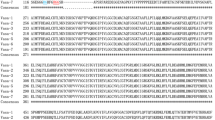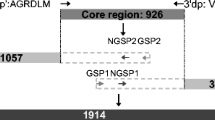Abstract
VASA is one of the important regulatory factors that determine the development of the reproductive system. However, no information on vasa gene from Pleocyemata Brachyura is available. By using Race, we obtained a full-length cDNA of Sp-vasa of the green mud crab Scylla paramamosain. The full-length (2,851 bp) cDNA of vasa encodes a peptide of 631 amino acids. Real-time PCR results indicated that the expression level of Sp-vasa in the growth stage of ovary was higher than in the maturation stage, and in stage I and II of testis, the expression level of Sp-vasa were higher than in stage III. By using in situ hybridization, Sp-vasa RNAs were detected in the large part of oocyte plasm in stage I, nucleus zone in stage III and perinuclear zone in stage V. As the size of oocytes increases during oogenesis, the signals change from strong to weak. In addition, in stage I and II of testis, the expression levels of Sp-vasa were higher than in stage III, and the hybridization intensity of Sp-vasa gene gradually increased during spermatogenesis from spermatogonia to spermatids. However, no hybridization signal was detected in spermatozoon. Real-time PCR and in situ hybridization were consistent. These findings suggest that Sp-vasa is likely to serve as a useful and specific marker for germ cell development of S. paramamosain.




Similar content being viewed by others
References
Lasko PF, Ashburner M (1988) The product of the Drosophila gene vasa is very similar to eukaryotic initiation factor-4A. Nature 335:611–617
Hay B, Jan LY, Jan YN (1988) A protein component of Drosophila polar granules is encoded by vasa and has extensive sequence similarity to ATP-dependent helicases. Cell 55:577–587
Rocak S, Linder P (2004) DEAD-box proteins: the driving forces behind RNA metabolism. Nat Rev Mol Cell Biol 5:232–241
Linder P (1989) Birth of the DEAD box. Nature 337:121–122
Schüpbach T, Wieschaus E (1986) Maternal-effect mutations altering the anterior-posterior pattern of the Drosophila embryo. Dev Genes Evol 195:302–317
Tomancak P, Guichet A, Zavorszky P, Ephrussi A (1998) Oocyte polarity depends on regulation of gurken by Vasa. Development 125:1723–1732
Gavis ER, Lunsford L, Bergsten SE, Lehmann R (1996) A conserved 90 nucleotide element mediates translational repression of nanos RNA. Development 122:2791–2800
Kobayashi T, Kajiura-Kobayashi H, Nagahama Y (2000) Differential expression of vasa homologue gene in the germ cells during oogenesis and spermatogenesis in a teleost fish, tilapia, Oreochromis niloticus. Mech Dev 99:139–142
Marracci S, Casola C, Bucci S, Ragghianti M, Ogielska M, Mancino G (2007) Differential expression of two vasa/PL10-related genes during gametogenesis in the special model system Rana. Dev Genes Evol 217:395–402
Nakkrasae LI, Damrongphol P (2007) A vasa-like gene in the giant freshwater prawn, Macrobrachium rosenbergii. Mol Reprod Dev 74:835–84214
Xu H, Gui J, Hong Y (2005) Differential expression of vasa RNA and protein during spermatogenesis and oogenesis in the gibel carp (Carassius auratus gibelio), a bisexually and gynogenetically reproducing vertebrate. Dev Dyn 233:872–882
Zhou QR, Shao MY, Qin ZK, Kyoung HK, Zhang ZF (2010) Cloning, characterization, and expression analysis of the DEAD-box family genes, Fc-vasa and Fc-PL10a, in Chinese shrimp (Fenneropenaeus chinensis). Chin J Oceanol Limnol 28:37–45
Parvinen M (2005) The chromatoid body in spermatogenesis. Int J Androl 28(4):189–201
Extavour CG, Akam M (2003) Mechanisms of germ cell specification across the metazoans: epigenesis and preformation. Development 130:5869–5884
Leroy P, Alzari P, Sassoon D, Wolgemuth D, Fellous M (1989) The protein encoded by a murine male germ cell-specific transcript is a putative ATP-dependent RNA helicase. Cell 57:549–559
Noce T, Fujiwara Y, Ito M, Takeuchi T, Hashimoto N, Yamanouchi M, Higashinakagawa T, Fujimoto H (1993) A novel murine zinc finger gene mapped within the tw18 deletion region expresses in germ cells and embryonic nervous system. Dev Biol 155:409–422
Palombi F, Di Carlo C (1988) Alkaline phosphatase is a marker for myoid cells in cultures of rat peritubular and tubular tissue. Biol Reprod 39:1101–1109
Takagi Y, Talbot NC, Rexroad CE Jr, Pursel VG (1997) Identification of pig primordial germ cells by immunocytochemistry and lectin binding. Mol Reprod Dev 46:567–580
Yoon C, Kawakami K, Hopkins N (1997) Zebrafish vasa homologue RNA is localized to the cleavage planes of 2-and 4-cell-stage embryos and is expressed in the primordial germ cells. Development 124:3157–3165
Cordin O, Banroques J, Tanner NK, Linder P (2006) The DEAD-box protein family of RNA helicases. Gene 367:17–37
Raz E (2000) The function and regulation of vasa-like genes in germ-cell development. Genome Biol 1:1017
Chen YD, Zou ZH, Wang YL, Zhang ZP (2010) Progress in studies of vasa gene. Dongwuxue Zazhi 45:173–180 (In Chinese)
Sagawa K, Yamagata H, Shiga Y (2005) Exploring embryonic germ line development in the water flea, Daphnia magna, by zinc-finger-containing VASA as a marker. Gene Expr Patterns 5:669–678
Aflalo ED, Bakhrat A, Raviv S, Harari D, Sagi A, Abdu U (2007) Characterization of a vasa-like gene from the pacific white shrimp Litopenaeus vannamei and its expression during oogenesis. Mol Reprod Dev 74:172–177
Özhan-Kizil G, Havemann J, Gerberding M (2009) Germ cells in the crustacean Parhyale hawaiensis depend on Vasa protein for their maintenance but not for their formation. Dev Biol 327:230–239
Wang GZ, Li SJ, Zeng CS, Lin SJ, Kong XH, Ai CX, Lin QW (2005) Status of biological studies and aquaculture development of the mud crab, Scylla serrata China: an experimental ecological studies. Aquac Int 13:459–468
Sugama K, Hutapea JH (1999) Genetic charaterisation in the mud crab Scylla (Brachyura: Portunidae). In: Keenan CP, Blackshaw A (eds) Mud crab aquaculture and biology. Watson Ferguson & Co., Brisbane, pp 43–47
Li SJ, Wang GZ (2001) Studies on reproductive biology and artificial culture of mud crab, Scylla serrata. Xiamen Da Xue Xue Bao Zi Ran Ke Xue Ban 40:552–565 (In Chinese)
Zou ZH, Zhang ZP, Wang YL, Chen JM, Jia XW, Wang SH, Lin P (2009) The construction of normalized cDNA library and preliminary EST analysis from the gonad development and sexual differentiation related organs of Scylla serrata. J Trop Oceanogr 28:88–94 (In Chinese)
Zou ZH, Zhang ZP, Wang YL, Han KH, Fu MJ, Lin P, Jia XW (2011) EST analysis on the gonad development related organs and microarray screen for differential expressed genes in mature ovary and testis of Scylla paramamosain. Comp Biochem Physiol 6:150–157
Caruthers JM, McKay DB (2002) Helicase structure and mechanism. Curr Opin Struct Biol 12:123–133
Tanner NK (2003) The newly identified Q motif of DEAD box helicases is involved in adenine recognition. Cell cycle 2:18–19
Rogers GWJ, Komar AA, Merrick WC (2002) eIF4A: the godfather of the DEAD box helicases. Prog Nucleic Acid Res Mol Biol 72:307–331
Benz J, Trachsel H, Baumann U (1999) Crystal structure of the ATPase domain of translation initiation factor 4A from Saccharomyces cerevisiae-the prototype of the DEAD box protein family. Structure 7:671–679
Sui J, Zhang ZF, Shao MY, Hu JJ (2008) Cloning and characterization of a vasa-like gene in Apostichopus japonicus and its expression in tissues. Zhongguo Shui Chan Ke Xue 15:407–413
Kobayashi T, Kajiura-Kobayashi H, Nagahama Y (2002) Two isoforms of vasa homologs in a teleost fish: their differential expression during germ cell differentiation. Mech Dev 111:167–171
Hu CJ, Wu FR, Liu ZH, Huang BF, Zhang YG, Wang DS (2008) Molecular cloning and expression of two isoforms of Vasa gene in Southern catfish Silurus meridionalis. Dong Wu Xue Bao 54:1051–1060 (In Chinese)
Fabioux C, Corporeau C, Quillien V, Favrel P, Huvet A (2009) In vivo RNA interference in oyster–vasa silencing inhibits germ cell development. FEBS J 276:2566–2573
Cardinali M, Gioacchini G, Candiani S, Pestarino M, Yoshizaki G, Carnevali O (2004) Hormonal regulation of vasa-like messenger RNA expression in the ovary of the marine teleost Sparus aurata. Biol Reprod 70:737–743
Xiang F, Zhen Y, Zheng WX, Deng FJ, Wang XK, Zhang XY (2004) The expression of vasa gene during zebrafish (Danio rerio) oogenesis. Wuhan Da Xue Xue Bao Zi Ran Ke Xue Ban 9:979–982 (In Chinese)
Raghuveer K, Senthilkumaran B (2010) Cloning and differential expression pattern of vasa in the developing and recrudescing gonads of catfish, Clarias gariepinus. Comp Biochem Physiol A 157:79–85
Komiya T, Itoh K, Ikenishi K, Furusawa M (1994) Isolation and characterization of a novel gene of the DEAD box protein family which is specifically expressed in germ cells of Xenopus laevis. Dev Biol 162:354–363
Tanaka SS, Toyooka Y, Akasu R, Katoh-Fukui Y, Nakahara Y, Suzuki R, Yokoyama M, Noce T (2000) The mouse homolog of Drosophila Vasa is required for the development of male germ cells. Genes Dev 14:841–853
Toyooka Y, Tsunekawa N, Takahashi Y, Matsui Y, Satoh M, Noce T (2000) Expression and intracellular localization of mouse Vasa-homologue protein during germ cell development. Mech Dev 93:139–149
Acknowledgments
The work was support by Natural Science Foundation of China (No.30571430, No. 31072200), Natural Science Foundation of Fujian Province (No.2009J01179) and Innovation Team Foundation of Jimei University (No.2010A001). We thank Mr. Ion Beldorth, Department of Chemistry and Biochemistry, Texas State University for his proof reading of the manuscript.
Author information
Authors and Affiliations
Corresponding author
Additional information
GenBank accession number: ACZ92304.
Electronic supplementary material
Below is the link to the electronic supplementary material.
11033_2011_1220_MOESM1_ESM.tif
Fig. S1. The nucleotide and deduced amino acid sequences of Sp–vasa gene. The nucleotide sequence is displayed in the 5′ → 3′ directions and numbered to the right and left. Nine conserved domains are underlined with bold letter. GG Rich region is highlighted in grey color. Two CCHC structures of VASA are in bold. RGG repeat region is double underlined. The predicted phosphorylation sites are in boxes. (TIFF 157 kb)
11033_2011_1220_MOESM3_ESM.tif
Fig. S2. Multiple alignment of the VASA amino acid sequence between S. paramamosain and other species. The abbreviations were used for species with GenBank Accession no. as follows: Scylla paramamosain, ACZ92304; Litopenaeus vannamei, AAY89069; Fenneropenaeus chinensis, ABQ00071; Parhyale hawaiensis, ACH92926; Daphnia magna, BAD99522; Crassostrea gigas, AAR37337; Chlamys farreri, ABE27759; Haliotis asinina, ACT35657; Strongylocentrotus purpuratus, NP_001139665; Ciona savignyi, BAB12217; Platynereis dumerilii, CAJ38803; Danio rerio, AAL89410; Gallus gallus, BAB12337; Homo sapiens, AAF72705; Apis mellifera, ABC41341; Drosophila melanogaster, NP_723899; Bombyx mori, NP_001037347. (TIFF 635 kb)
11033_2011_1220_MOESM7_ESM.tif
Fig. S3. Phylogenetic tree of the VASA amino acid sequence between S. paramamosain and other species. Mus. musculus Ddx5 protein was used as the out-group. Numbers indicate the bootstrap confidence values of 1000 replicates. The accession numbers of the selected VASA sequences see Fig. S2. (TIFF 193 kb)
Rights and permissions
About this article
Cite this article
Wang, Y., Chen, Y., Han, K. et al. A vasa gene from green mud crab Scylla paramamosain and its expression during gonadal development and gametogenesis. Mol Biol Rep 39, 4327–4335 (2012). https://doi.org/10.1007/s11033-011-1220-5
Received:
Accepted:
Published:
Issue Date:
DOI: https://doi.org/10.1007/s11033-011-1220-5




